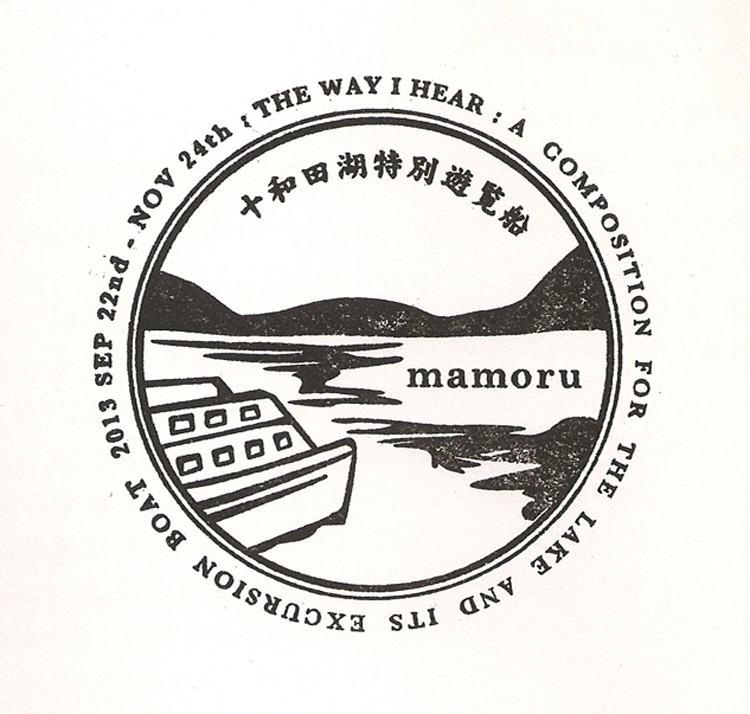THE WAY I HEAR, Lake Towada 2013
About the Project Performance/Composition
The crew give the program to all the passengers and tell them to wait for the announcement as they go on board.
<music, announcement/ boat: before departure, still / engine noise; none>
"I thank you for coming to the Towada Oirase Art Festival, especially taking time to be at Lake Towada, and for my work.
There are a few things to inform and request before the departure.
First, in case of emergency, there are life vests and emergency boats equipped on this ship. Please see the instructions on the wall for more details.
During the cruising, you may go in and out of the room freely; please enjoy the view from the ship deck anytime as you wish. Smoking is prohibited.
I would like to ask you to turn off your mobile phone and other electronic devices that might make any sound. The work requires your corporation.
The show will be starting in a minuet."
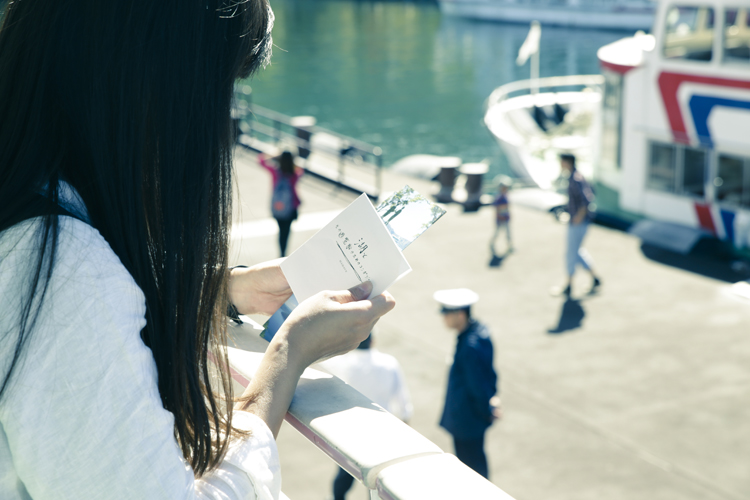
<announcement/ boat: departing / engine noise: minimum>
"Please open the program, and read the facing pages.
It says…
2013.June.25 Sunny, Arrived at the Lake Towada"
<written text on the first facing pages>
(on the left page)
2013.June.25 Sunny, Arrived at the Lake Towada
The sun is already going down, and all over the lake, the waves shine in gold.
I see no one around, but a car parked in a little distance with its engine on.
As I sit at the pier, the ships, the lake, and the mountains start to get veiled with purple-blue.
(on the right page)
18:47
I hear…
a fish jumpes out of the water in front of me
some sparrows calling in the woods near by
rippling waves on the ship
footsteps from behind me, and they stop after a little while
a bird chirps
a fish jumps again
As I stand up, start walking, and leaving the lake behind a little, I hear a small motorboat sailing across the lake, making loud sound.
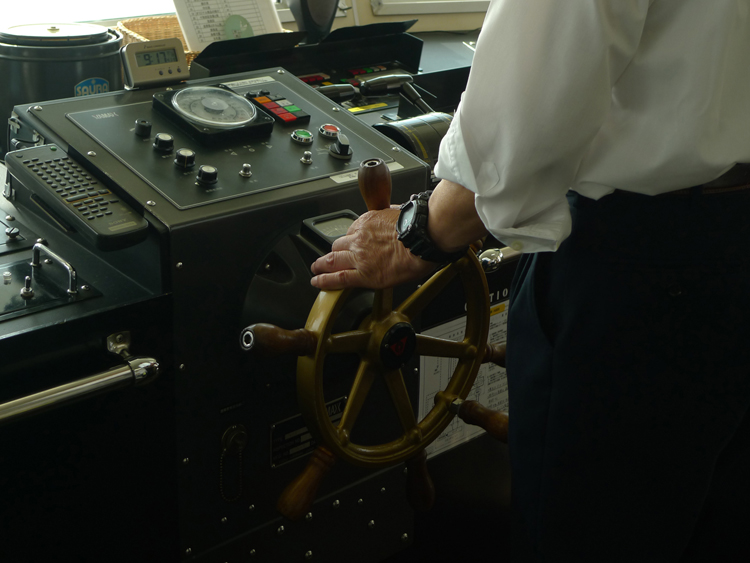
<announcement/ boat: moving / engine: gearing from low to top>
"When I visited here in June, there were spring-cicada, and I saw sparrows flying around.
How is it today?
Is it sunny?
Is it windy?
Do you hear anything from the lakeside?
Someone talking? A bus or a car?
birds
What about the sound in the ship?
feel any vibration of the engine?
the engine becomes louder
splash in the back of the ship
you can't hear me anymore.
Now begins the cruise"
There is a long break while the boat is moving fast from the west lake to the middle lake.
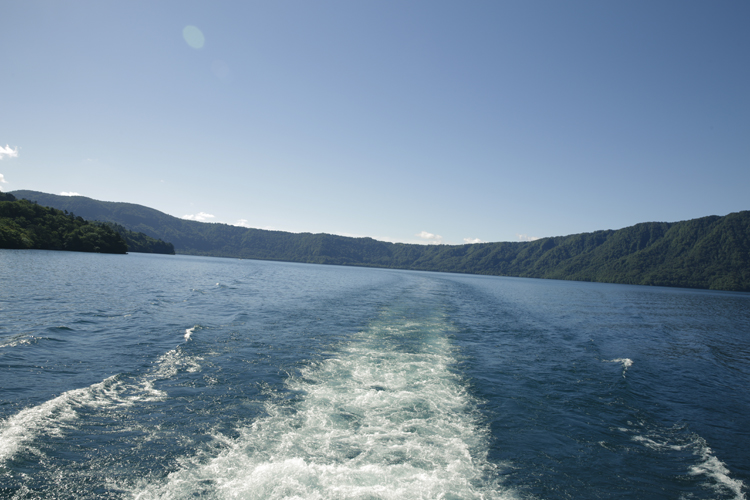
<the captain speaking with microphone/ boat: moving fast / engine noise: maximum>
"We will pass a viewing point where you can have a full view of the lake.
Please enjoy the view from the ship deck as well"
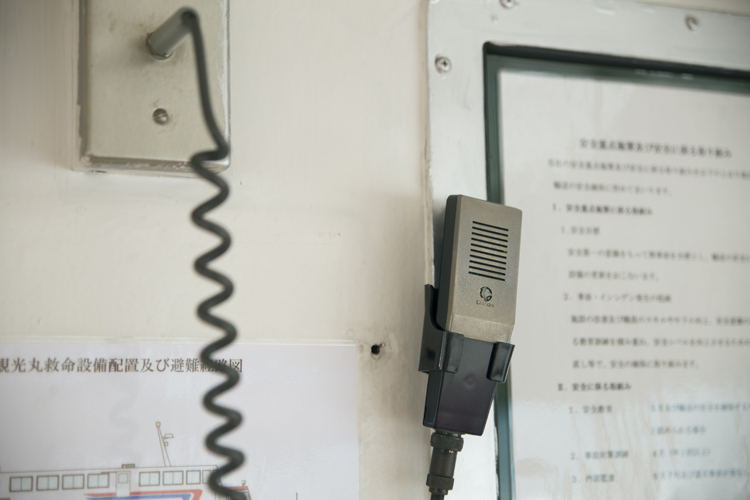
"Pleas have your program ready. Flip the page you opened before, and read the next facing page.
It says….
2013.6.26. I interviewed an old fisherman"
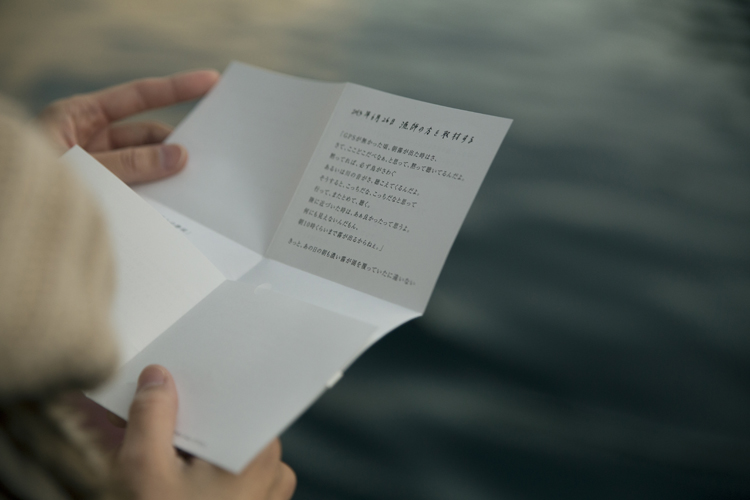
(on the right page)
2013.6.26. I interviewed an old fisherman
"You know, this is before GPS.
When I get lost in the morning fog,
I wonder where I am, then shut myself and listen to what's around.
If you keep yourself quiet, the birds will start to make a noise.
Or you might hear the stream of river.
Then I can guess where I am heading and get closer to the shore.
Listen again, and get closer to the shore.
What a relief when you actually made it to the shore.
You can't see anything, you know, it's foggy until 10am or so."
That morning, there must have been fog over the lake.
(on the left page)
"silence on the lake"
<announcement/ boat: floating / engine noise: minimum>
"I listen to the lake, wondering where I am.
Can you hear anything? (whispering voice)
What do you see? (whispering voice)
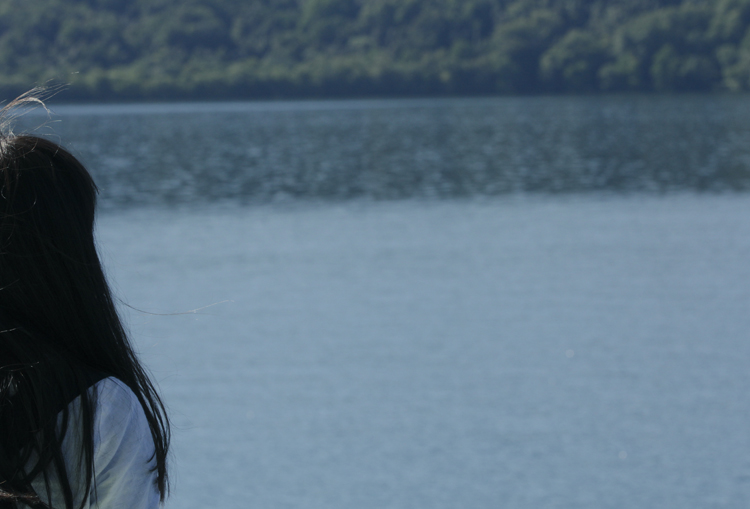
<announcement/ boat: still, floating/ engine noise: none, minimum>
"On that day 1100 years ago, there was a strong easterly wind around here, and it was a chilly day for August.
915.Aug.7th
out of nowhere, the rumbling of the earth
and all of a sudden, huge eruption with the thundering noise
volcanic fumes rising into the sky, higher and higher
massive amount of stones are falling from above
and a destructive stream of heated rocks and ashes are blown towards west with the strong wind, going over the mountain, further and further away
Into the bottom of the hollowed crater,
indescribable silence went down.
The stillness and the blue water has kept it covered since."

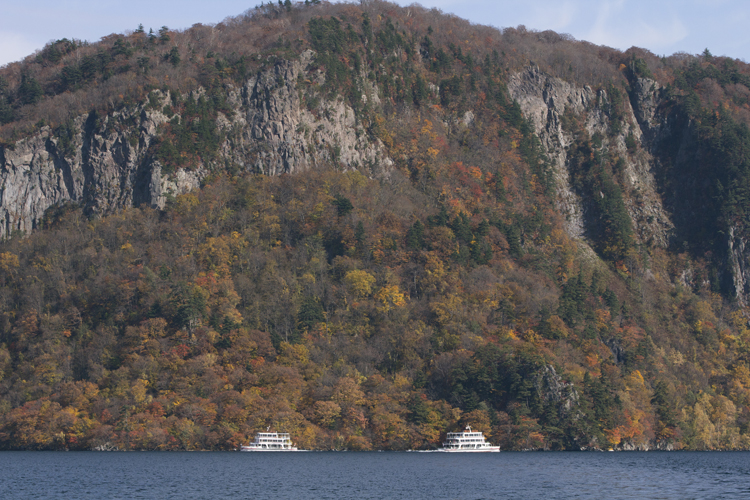
<the captain speaking with microphone/ boat: gradually moving/ engine noise: gearing up, becoming louder>
"We will now go back to the west lake."

There is a long break while the boat goes back towards the west lake.

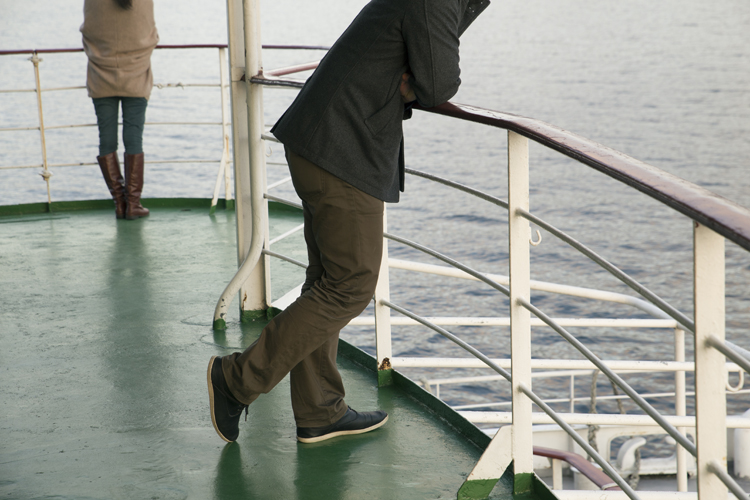
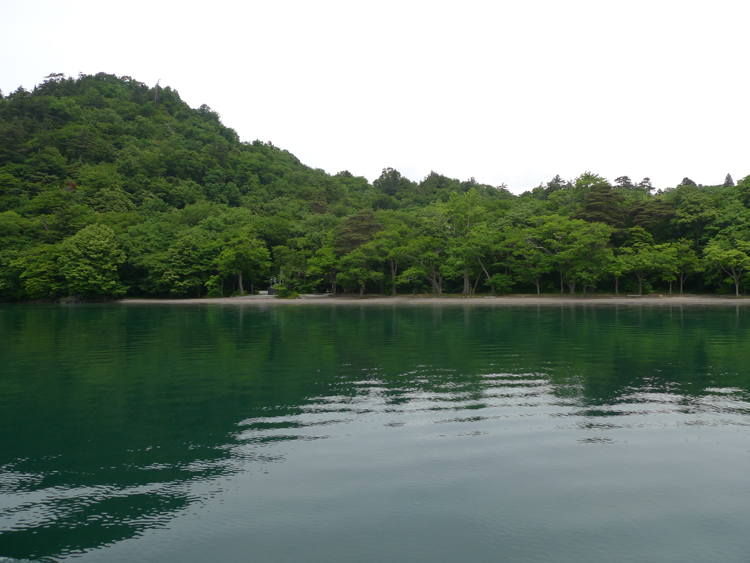
<music, announcement/ boat: moving slowly/ enginge noise: minimum>
"I joined a guided walk during my stay at Lake Towada. Since it was a weekday and very early in the morning, I was the only one to join. The guide was telling me about the trees or birds you can see around the lake, and we were walking towards the sculpture you are seeing on your left side.
She asked me a question as we were going into the Towada shrine from the sculpture. 'Have you heard about the legend of Hachi-no-Taro and the monk Nansobo?'
'Yes, and I have researched about the legend a little.' I said.
It goes like this …
Once upon a time, the monk Nansobo who were trained in Kumano shrine and had gone around Japan, came to Lake Towada. Hachi-no-Taro, the large snake who had been the master of the lake fought against the monk. Then Hachi-no-Taro was eventually defeated after seven days and seven nights of the desperate battle. He left the lake, wondered around, ended up damming up a river, and made another lake for him to stay. This is Lake Hachiro in Akita today. The monk Nansobo who now became the master of Lake Towada went deeply into the lake, became a blue dragon and rests still today.
She said, 'You probably thought it's just a myth, but for me … '
and she told me how scarily it was to hear the story from her grandmother. Also, she had believed that the red rocks and reddish soil around the lake is the blood of the large snake and the dragon.
It struck me that I can still hear the echoes of the legend among people today.
I wonder where I am, and listen to what's around.
a wind touches my face,
and I hear a ship getting closer to the shore."
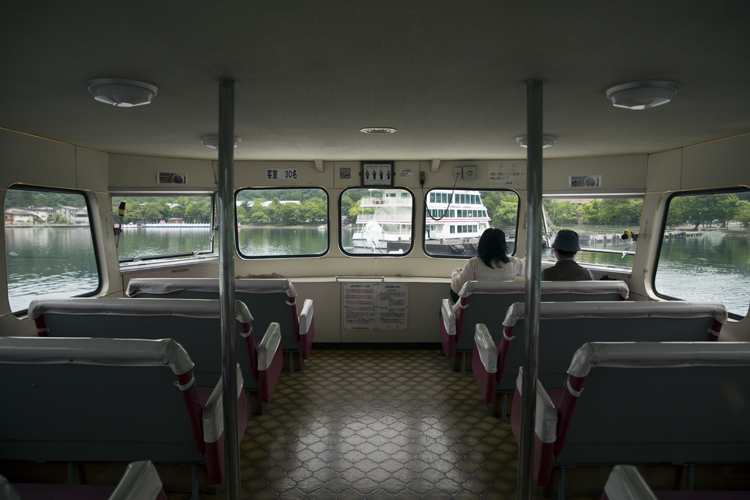
The ship has arrived at the pier,
puts the gear down,
and adds some silence in the lake.
I decided to spend a little more time around the shore, and listen to what's around."
(break with short musical phrase)
"This is the end of cruising.
The last sealed page of the program is for you to read after leaving the ship.
Please take little more time to walk around the lake, find a good place for reading. I hope you enjoy.
Please don't forget to put the stamp on the back of your program at the ticket counter.
The stamp is a part of the work.
Please check your belongings once again before you leave the ship."
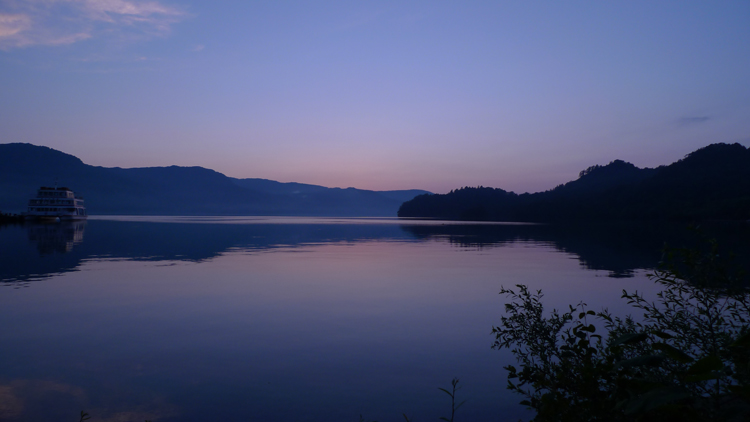
(Last sealed pages of the programs)
"silence on the lake"
The volcanic eruption of Mt.Towada in 915 made destructive impact in the region. According to the excavational investigation, there were rising numbers of houses and colonies around the main road of the region in the 10th century, so that we can imagine how people stood up and started rebuilding their country. I wondered what was like around Lake Towada, and looked into the maps of historical remains. I found no trace of human lives. It maybe understandable that no one settles in the deep mountain of the volcanic area, but I also felt some intentions there.
The people made huge effort to recover the land, and at the same time, left warning for their children and descendants to be careful with the volcano, and not to live near lake Towada. The images of the "large snake" or the "dragon" may represent the natural disaster. The legend of Hachi-no-Taro and the monk Nansobo is widely spread in Tohoku area as if it reflects the ashes-striken-area. It cannot be a coincident that the pyroclastic flow went along River Yonashiro, which goes towards Lake Hachiro, the lake Hachi-no-taro end up living. First of all, Hachi-no-Taro became a large snake after eating all of the char in the river for himself. This can be interpreted that the large snake had eaten up all the fish in the lake, and no fish ever lived after that, so it is hard to live around the lake. It also echoes with famous saying about Lake Towada that there were no fish before the trout farming. The monk Nansobo became a dragon according to the legend, and this might also be the warning that he has just been quiet, and if anyone invade the territory carelessly, he may fire and bring destruction.
I listened into the silence very carefully if anyone was there inside the "boundary" set around the lake.
The Towada shrine has been one of the most important sacred place among the mountain priests in Tohoku area. They enshrine the great blue dragon/the monk Nansobo, and also the god of Gold. It often mentioned the connection between the mountain priests and mines, and in fact there are places named Lead Mt and Silver Mt on the west coast of Lake Towada. The Lead Mt. was found in mid 17th Century according to the official account of Nanbu state. (this area belonged to Nanbu back then.)
Mid 17th Century, mines, Nanbu…
They remembered me one thing; Christians.
During the 16th and the 17th century in Japan, around the end of the civil war period, Christianity became one of the big stream of the time. Regardless of the classes, a lot of lords and normal people converted to it. However, after Christianity was banned by the law strictly set by the rulers of the time, such as Hideyoshi and first 3 shogun of Tokugawa, the believers were martyred and persecuted. Many of them moved into Tohoku area from all over Japan. Since there were a lot of mines, and at the mines, no one would be asked their origins nor belief; The local lords needed anyone, including Christians and criminals as the labor. According to the accounts of the missionaries, and Nanbu state documents, also to the fact that there were even gold mine near by the lake, it is very certain that Christians must have been around here as miners. As I researched more about it, I found that the Tokugawa government forced Nanbu state to make investigation even among the mines to arrest the Christians in 1639. Also, the last account of martyr in Nanbu recorded in 1665, the same year Lead Mt. was found. It is hard to think they extinct right after that year. Didn't they run away into somewhere they can hide? Wasn't inside of the "boundary" of Lake Towada best suit for them?
When I heard that there is an old wooden chapel on the west coast of the lake, I first thought that I finally found the evidence; however, the chapel was built by an American missionary after WW2 and it seems that there is no relation to the Medieval Christians. I just couldn't give up the idea, so I decided to visit the chapel. I walked over a muddy, grassy, narrow path, and kept wondering if they had hidden and prayed or sung hymns in the woods, or if they worked at the lead mine. Because of the sudden change of the weather, I had to give up visiting the chapel and came back the same path again. I lost track of them as if they vanish into the fog. I tried to listen to them again, but heard nothing other than winds.
Did I hear it wrong?
I don't know, but I heard something in the silence on the lake,
and I do know little more about where I am.
2013. September mamoru
